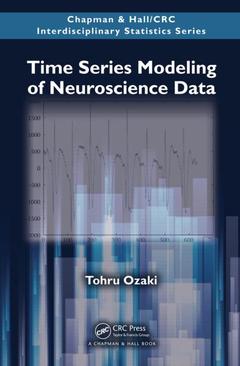Time Series Modeling of Neuroscience Data Chapman & Hall/CRC Interdisciplinary Statistics Series
Auteur : Ozaki Tohru

Recent advances in brain science measurement technology have given researchers access to very large-scale time series data such as EEG/MEG data (20 to 100 dimensional) and fMRI (140,000 dimensional) data. To analyze such massive data, efficient computational and statistical methods are required.
Time Series Modeling of Neuroscience Data shows how to efficiently analyze neuroscience data by the Wiener-Kalman-Akaike approach, in which dynamic models of all kinds, such as linear/nonlinear differential equation models and time series models, are used for whitening the temporally dependent time series in the framework of linear/nonlinear state space models. Using as little mathematics as possible, this book explores some of its basic concepts and their derivatives as useful tools for time series analysis. Unique features include:
The main point of interest in this book is to show that the same data can be treated using both a dynamical system and time series approach so that the neural and physiological information can be extracted more efficiently. Of course, time series modeling is valid not only in neuroscience data analysis but also in many other sciences and engineering fields where the statistical inference from the observed time series data plays an important role.
Introduction. Dynamic Models for Time Series Prediction: Time Series Prediction and the Power Spectrum. Discrete-Time Dynamic Models. Multivariate Dynamic Models. Continuous-Time Dynamic Models. Some More Models. Related Theories and Tools: Prediction and Doob Decomposition. Dynamics and Stationary Distributions. Bridge between Continuous-Time Models and Discrete-Time Models. Likelihood of Dynamic Models. State Space Modeling: Inference Problem (a) for State Space Models. Inference Problem (b) for State Space Models. Art of Likelihood Maximization. Causality Analysis. The New and Old Problems. References. Index.
Tohru Ozaki is a mathematician and statistician. He received his BSc in mathematics from the University of Tokyo in 1969. He then joined the Institute of Statistical Mathematics (ISM), Tokyo, in 1970 and study and worked with Hirotugu Akaike. He received his DSc from Tokyo Institute of Technology in 1981 under the supervision of Akaike. From 1987 to 2008, he was a professor at ISM and, after Akaike’s retirement, served as the director of the prediction and control group. His major research areas include time series analysis, nonlinear stochastic dynamic modeling, predictive control, signal processing and their applications in neurosciences, control engineering, and financial engineering.
While he was at ISM, Ozaki was engaged in various projects in applied time series analysis in science and engineering: EEG dynamic inverse problems, spatial time series modeling of fMRI data, causality analysis in behavioral science, modeling nonlinear dynamics in ship engineering, predictive control design in fossil power plant control, seasonal adjustment in official statistics, heteroscedastic modeling and risk-sensitive control in financial engineering, nonlinear dynamic modeling in macroeconomics, spectral analysis of seismology data, point process modeling of earthquake occurrence data, river-flow prediction in stochastic hydrology, etc.
Ozaki retired from ISM in 2008. Since then he has been a visiting professor at Tohoku University, Sendai, Japan, and at Queensland University of Technology, Brisbane, Australia. He has been involved in supporting several research projects (in dynamic modeling of neuroscience data, fossil power plant control design, and risk-sensitive control in financial engineering) in universities and industry. He has also led, through his international research network, a time series research group called Akaike Innovation School from his office in Mount Fuji and organizes seminars every summer.
Date de parution : 02-2012
Ouvrage de 320 p.
15.6x23.4 cm
Thèmes de Time Series Modeling of Neuroscience Data :
Mots-clés :
State Space Model; Gaussian White Noise; state; AR Model; space; ARMA Model; models; Continuous Time Dynamic Models; prediction; Stochastic Differential Equation Model; errors; Nonlinear State Space Model; unobserved; Auto Covariance Function; variable; Observed Time Series Data; gaussian; Linear State Space Model; white; Power Spectrum; noise; Transition Matrix; Observation Errors; ExpAR Model; Prediction Errors; Discrete Time State Space Model; Prediction Error Variance; Markov Diffusion Processes; Multivariate AR; Continuous Time Models; Conditional Expectation; Continuous Time State Space Model; Nonlinear Time Series Model; Noise Variance; Discrete Time Dynamic Models



